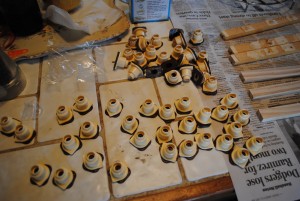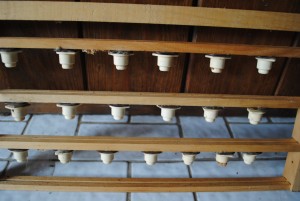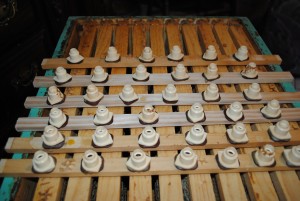
About 3 weeks late, I was finally able to start the first queen rearing program this past weekend. Today (well, yesterday, given the fact that my daughter woke me up and I’m unable to get back to sleep at this ungodly hour!) was Day 5 of my Nicot system.
The Nicot system utilizes a little contraption that you confine the queen in, for a day, so that she can lay eggs in it. You then take her eggs (the system has these little ‘cups’ that she lays in) and place them in a ‘starter’ hive to get going – that’s a VERY high level overview of what’s going on…
For me, yesterday was Day 5 in the system. I had to create a queenless scenario in one of my hives and install the cell frames. Today, I will need to actually move the egg cups onto the cell frames.

Although I have never tested this out, I have read in a few places that the best queens are ‘started’ by a queenless hive. Since I plan to ‘start’ my queens on Wed, I wanted to create a queenless situation on Tuesday and give the bees a day to really get worked up over losing their queen. My current method (I am, by no means, an expert here and continue to try different ways to achieve the best results) is to start with a hive that is on 2 Deeps and is going strong. I locate the queen and place her in the bottom Deep. Once she is secure, I turn the whole hive around and face it backwards. Finally, I place a bottom board on top of the lower deep, facing forward, and put the final Deep in place.
If you can picture this, both of the Deeps remain but they are now separated into two groups of bees. On the bottom, with the entrance facing behind, the queen continues working and building. Up top, with a new entrance facing forward (although a little higher) is the other half of the bees, who now have no access to the queen below. They shortly go into emergency replacement mode.
It is important to have some nurse bees up top, where the queens will be started. But, I will really dump them up there tomorrow. For right now, I simply want to make sure there are two masses of bees (on brood), one without a queen. I face the entrance of the new queenless hive in the same direction as the original entrance, to get most (if not all) of the foragers. I want this mini-hive to be roaring for the eggs they are going to receive a day later.
Finally, I drop my cell frame into the queenless hive. The real goal here is to make it familiar to the bees. It will smell like ‘part of their hive’ and be easier to accept when I add the eggs tomorrow.
 Finally, I have a few hives with the Deep/Deep setup. Their main purpose is to house my queen systems. When I was going around to determine who would hold the queen frames (I am doing several this year, so would like several hives to ‘start’ and ‘finish’ my queens), I did find another deadout! Argh! I didn’t have time to really get into the hive, but will do so tomorrow. My losses continue to creep up and it is painful, but it’s more emotional then anything else. I also came across a few double deeps that are great examples of queens to watch. They were really just barely working on 5 or 6 frames in the whole hive (frames with brood). The hives that I chose had brood on 13+ frames. It’s key to understand what ‘is roaring’ and what is ‘whimpering along’…
Finally, I have a few hives with the Deep/Deep setup. Their main purpose is to house my queen systems. When I was going around to determine who would hold the queen frames (I am doing several this year, so would like several hives to ‘start’ and ‘finish’ my queens), I did find another deadout! Argh! I didn’t have time to really get into the hive, but will do so tomorrow. My losses continue to creep up and it is painful, but it’s more emotional then anything else. I also came across a few double deeps that are great examples of queens to watch. They were really just barely working on 5 or 6 frames in the whole hive (frames with brood). The hives that I chose had brood on 13+ frames. It’s key to understand what ‘is roaring’ and what is ‘whimpering along’…

Reader Comments
Hi. I enjoy reading about queen rearing, something I haven’t ventured into yet except for having a split make their own queen. I have a question about the nurse bees. I had read some time ago about a study looking at the various “jobs” bees perform (guarding, gathering, nursing, hive maintenance, etc.) and this study suggested that bees don’t differentiate their entire life but rather will move from one task to another, responding to the needs of the hive. In other words, one is not born to be a guard bee or a nurse bee and that is the role her entire life. So, if you didn’t add any “nurse” bees, wouldn’t some bees begin to assume that role? Or would there be a delay in that response that might make it too late to rear queens? Just curious to see what you think about that.
Jim
Hey Jim –
All good questions. Here is a fairly high level answer.
Bees typically progress from one job to another, based on their age. So, most bees perform the role of guard, nurse, undertaker and forager throughout their life. In some cases, these tasks require certain developed aspects of the bee (for example, not every bee in the hive has the ability to actually create wax – it requires a gland that emerges around day 10 or so and is gone by day 19.)
But, you are correct that bees have been shown to revert to a previous job (although they rarely progress to a future job that requires an older bee). But, this is something that usually takes place at a major level (a hive with 60,000 bees suddenly needs wax because they were made homeless.) I need nurse bees that have a special gland that lets them produce queen food (or royal jelly) and I can’t wait for them to develop this gland over a few days. I actually need it at hour one. I need those eggs to be flushed with royal jelly immediately (the prime eggs that I moved are ones that have just changed from a straight piece of standing rice (with no jelly) to a small ‘c’ shape on the bottom of the cell in a pool of its first bit of royal jelly (which all bees, foragers and queens, get on day 1.) But, I need the bees to keep replenishing this at a high rate.)
Some of the terminology that I used in the above answer is not strictly correct, but it should explain why you need Nurse bees (a ton of them, if you’re lucky) for great queens.